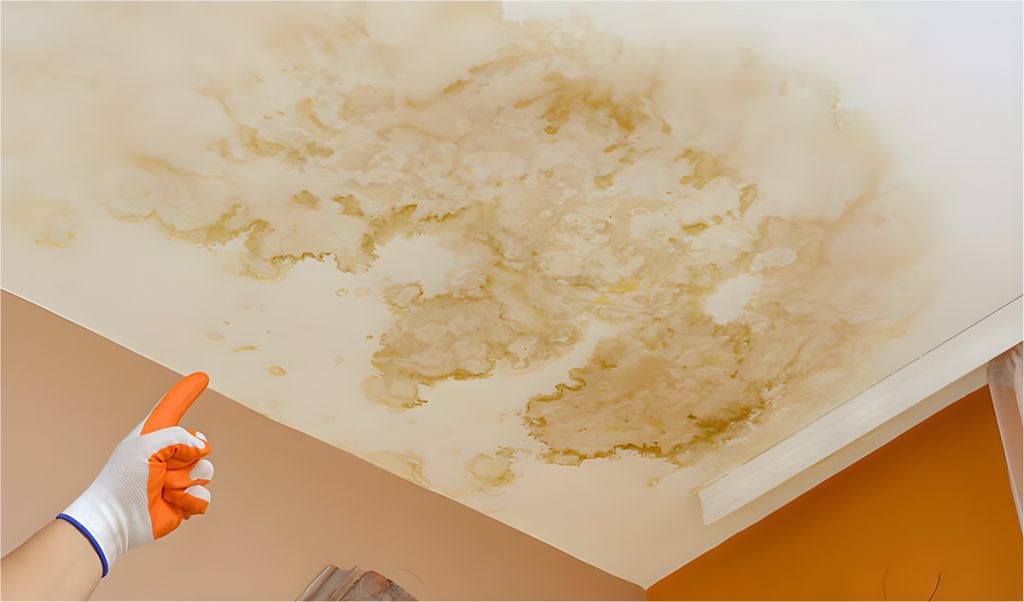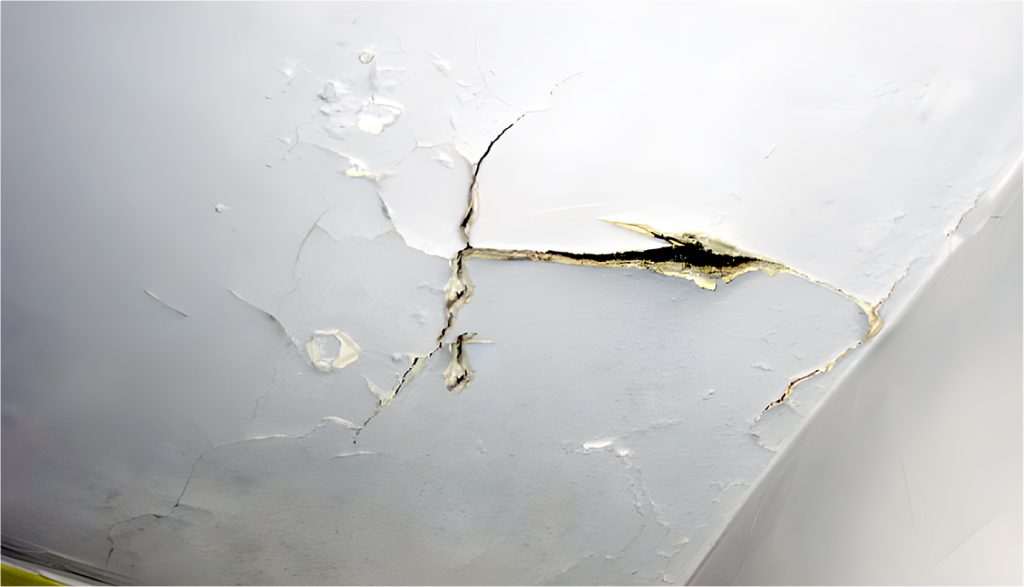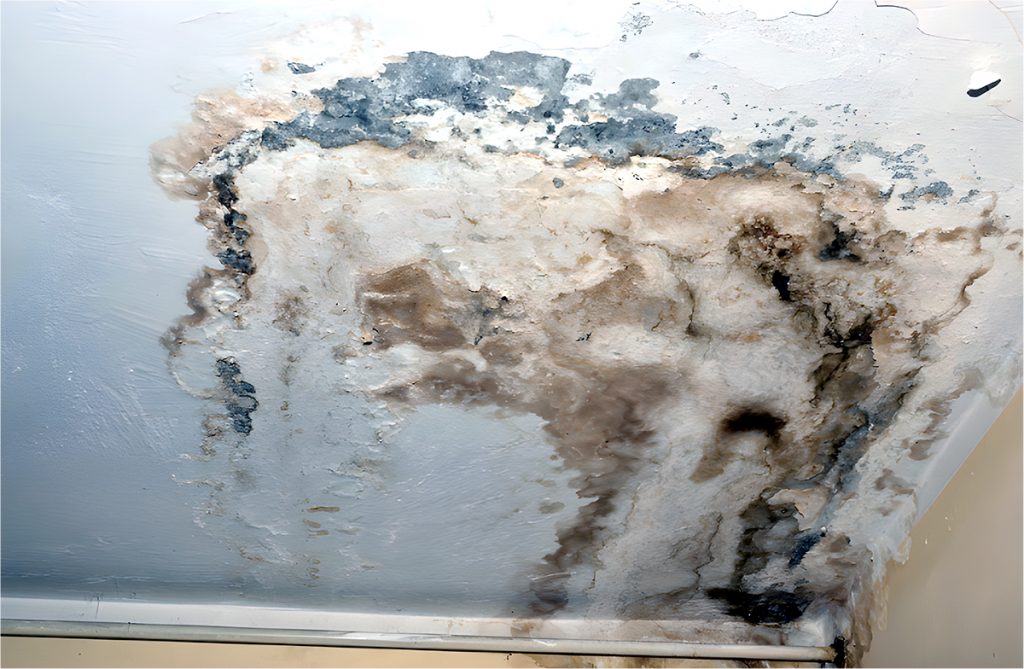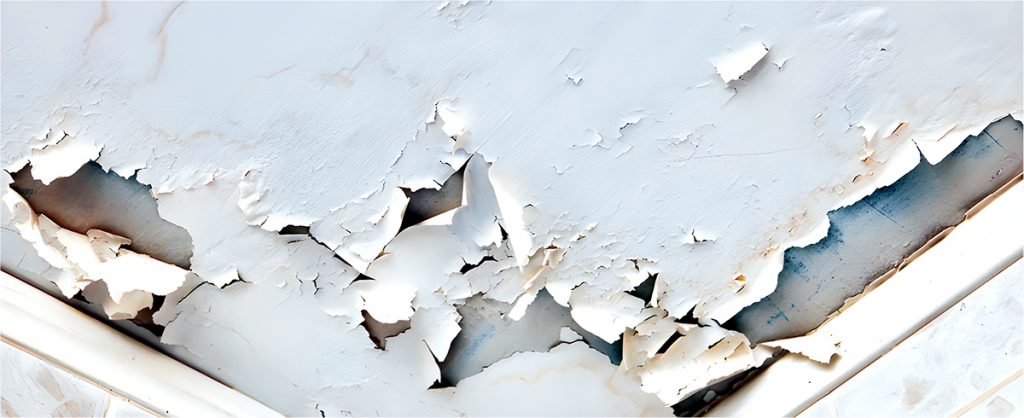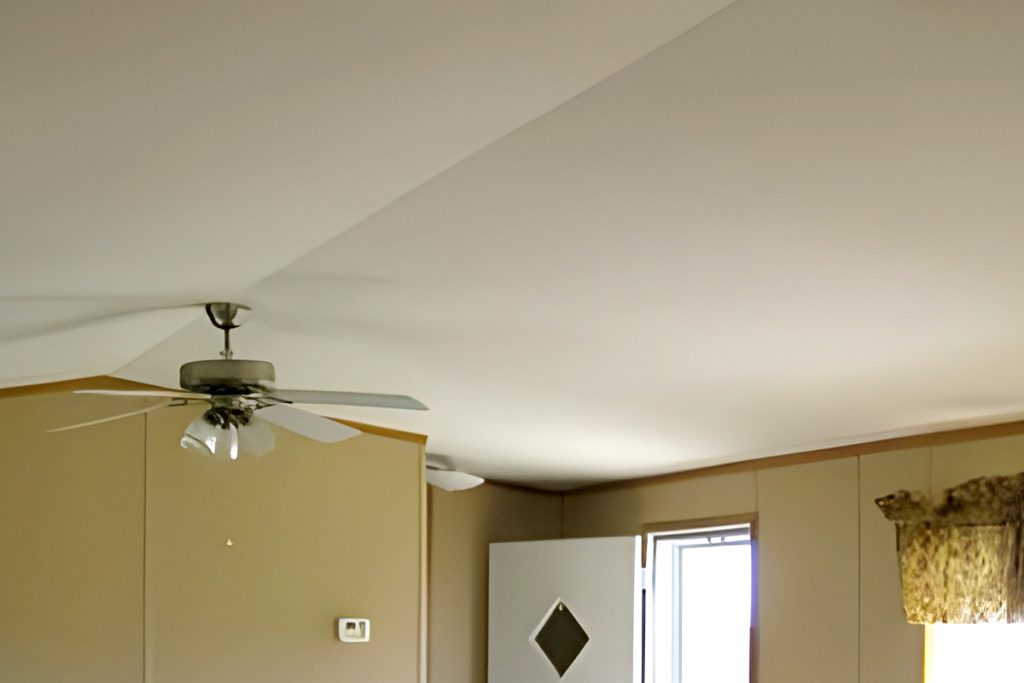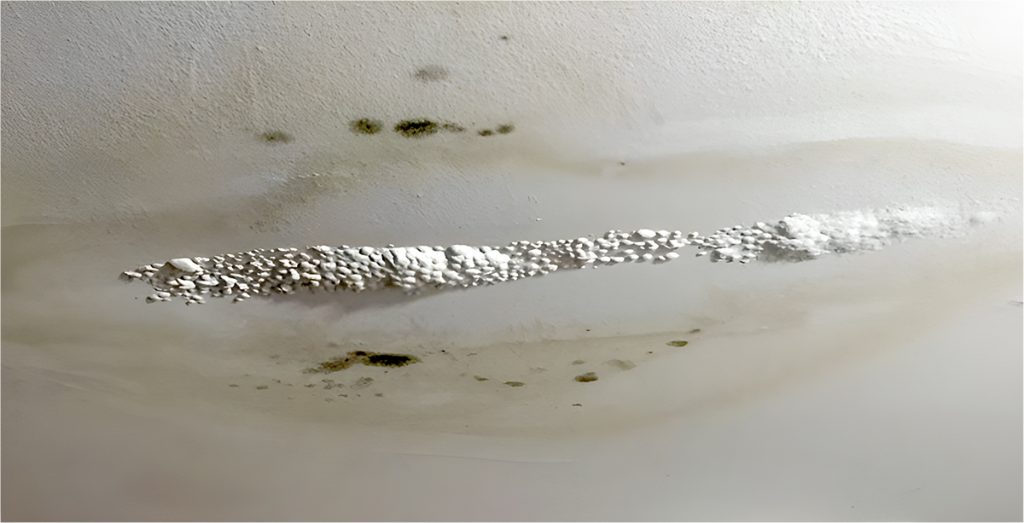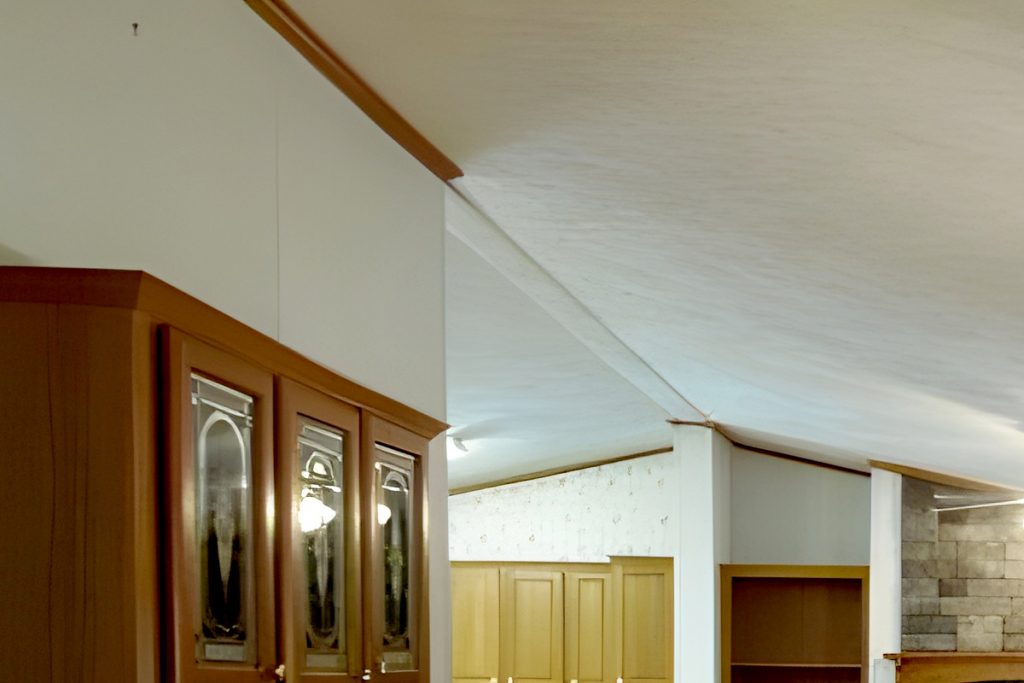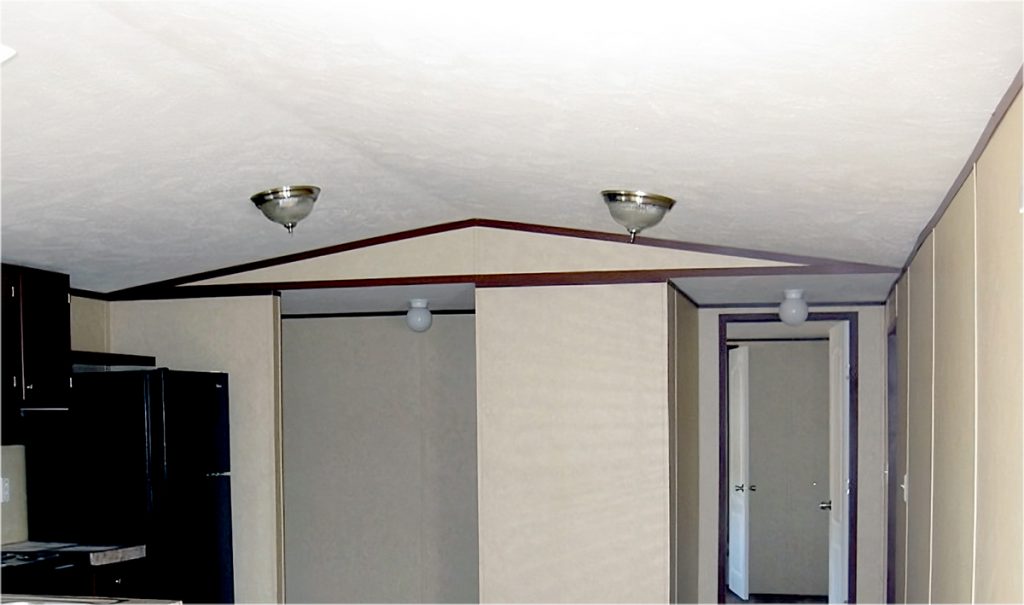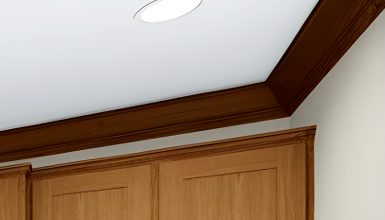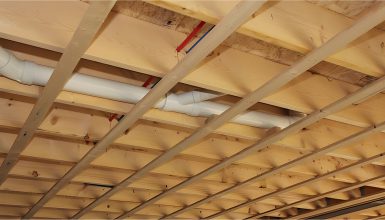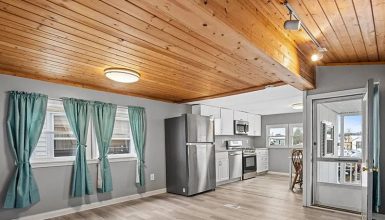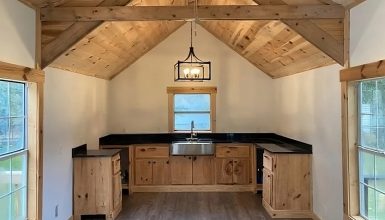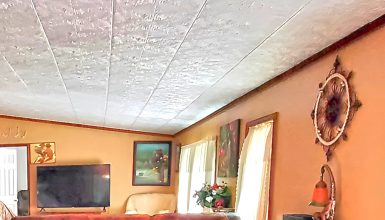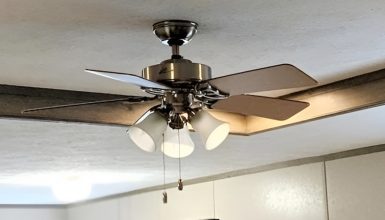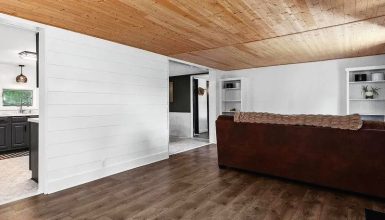Keeping up with a mobile home’s maintenance, especially the ceiling, is no walk in the park. It’s like a game of whack-a-mole – you fix one issue, another pops up. You’re not alone in this; it’s a universal experience for mobile homeowners. So, we will roll up our sleeves and delve into the common ceiling problems you might face. No need to sweat; we’ve got you covered with a roadmap to identify, tackle, and prevent these pesky issues. Let’s get down to business!
1. Water Damage Ceilings
Think about water. It’s essential, right? We need it to live, to cook, to clean. But when it starts seeping into your mobile home’s ceiling? The trouble with a capital ‘T.’ It’s the uninvited guest that can create a whole host of problems.
So, where’s this water coming from? Leaky roofs are the usual suspect. One small gap in your roof and the next rainstorm turns your ceiling into a watercolor canvas. You’ll notice splotches of brown and patches of dampness – all telltale signs of water’s unwanted visit.
But don’t rule out condensation or plumbing issues. Hot showers, cooking, and even breathing can cause condensation. And those water pipes running across your ceiling? They can spring leaks, adding to your water woes.
Why is water damage a big deal? Well, it’s not just about unsightly stains. It’s about structural damage, sagging ceilings, and the risk of mold. It’s about the health of your home and its people.
Repair Tips
Fret not! You can keep this menace at bay with regular checks and timely repairs. Find the source of the leak and fix it. Replace the damaged ceiling panels. Consider a dehumidifier to tackle condensation. And if plumbing is the culprit, call in a professional.
Remember, prevention is better than cure when it comes to water damage. Stay vigilant, and act promptly, and you can avoid this damp disaster. Your home’s ceiling is the roof over your head – let’s keep it dry, safe, and looking fabulous!
2. Ceiling Stains
We’ve all been there, gazing at a ceiling and seeing an unsightly stain. It’s like a blemish on a beautiful face – you just can’t ignore it. But more importantly, it’s a sign—a silent whisper of a potential problem lurking in your mobile home. So, let’s unravel the mystery of these ceiling stains.
Now, what causes them? Well, smoke from your culinary adventures or an over-enthusiastic candle can leave its mark. Those nicotine stains from cigarette smoke? They can cling to your ceiling like a bad habit.
But there’s more. Remember our uninvited guest, water? Yes, it can leave behind stains as it dries. The aftermath of a leak or condensation can look like a clumsy coffee spill on your ceiling.
And the real baddie here? Mold and mildew. These fungi love damp, dark places, and a water-stained ceiling is their idea of a perfect home. Not only do they cause unsightly black or green stains, but they can also lead to unpleasant odors and health issues. Yikes!
Repair Tips
Removing these unwelcome ceiling “tattoos” involves identifying and treating their source—clean smoke stains with warm water and dish soap. For mold, you’ll need a mixture of bleach and water. Always remember to wear gloves and keep the room well-ventilated.
You might need to repaint that part of your ceiling if you’ve got a stubborn water stain. And if water is the culprit, fix that leak ASAP to prevent further damage.
Stains can be a real eyesore, but with a keen eye and some elbow grease, your ceiling can return to being the flawless canopy it once was. Let’s wave goodbye to stains and hello to a clean, gorgeous ceiling!
3. Ceiling Cracks and Holes
Cracks and holes in your mobile home ceiling are like the unwelcome wrinkles of age – they sneak up on you, and before you know it, they’re there. But, unlike fine lines that tell the story of laughter and experiences, these blemishes on your ceiling can spell trouble.
So, what gives? Why the sudden appearance of these mini canyons and abysses on your ceiling? Most times, it’s good old wear and tear. The shifting of your mobile home, temperature changes, and humidity can all make your ceiling materials expand and contract, leading to cracks or holes.
Not a big deal, you think? Think again! These little imperfections are gateways for cold drafts, pesky insects, and water. That’s right. Those little cracks can let rainwater in and make your ceiling its playground.
Repair Tips
The good news is that you don’t have to live with them. Cracks and holes are like puzzles waiting to be solved. Get a sealant or a patching compound from your local hardware store and show those cracks who’s boss. Remember, the key is to fix them as soon as you spot them. The quicker you mend, the lesser the chance they become a bigger problem.
And if DIY isn’t your thing or the cracks are a little too menacing, don’t hesitate to call in a professional. Sometimes, it’s better to leave it to the experts.
So keep an eye out for these pesky ceiling invaders. Your ceiling can remain a seamless stretch of perfection with vigilance and care!
4. Sagging Ceilings
When you gaze up at your mobile home’s ceiling, you expect to see a flat, sturdy expanse. But what if your ceiling deviates from the norm and starts sagging? Suddenly, you’re living under a droopy, sad-looking canopy. Not ideal, right?
So, why is your ceiling acting like a hammock? The most common culprit is water damage. When water sneaks into your ceiling from a leaky roof or pipe, it can saturate the ceiling material, making it heavy and causing it to sag. Think of it like a soaked sponge, weighed down by the water it’s absorbed.
But water isn’t always to blame. Sometimes, improper installation or low-quality materials can also lead to sagging. Even the weight of the insulation in your ceiling can cause it to buckle under pressure.
A sagging ceiling isn’t just an aesthetic issue. It’s a potential safety hazard. If left unattended, that sag could progress to a complete collapse – and no one wants a ceiling on their head!
Repair Tips
Don’t worry, though. It’s not all doom and gloom. If you catch a sagging ceiling early, you can usually fix it before it becomes a real problem. It might involve replacing the damaged panels, reinforcing the ceiling joists, or installing a new, more robust ceiling.
5. Mold Growth Issues
Do you know what’s worse than an uninvited guest? An uninvited guest who refuses to leave. Meet mold, the persistent party-crasher of mobile home ceilings. Not only is it unsightly, but it’s also a potential health hazard. That’s right; mold isn’t just messing with your home’s looks. It’s messing with your health too!
Mold loves moisture. Give it a damp, dark spot, and it’ll settle in happily. That leaky roof or the condensation from your hot showers can create the perfect mold-friendly environment on your ceiling.
The mold starts as a small patch, but let it be, and it’ll spread, turning your ceiling into a blotchy, greenish-black mess. But the color change isn’t the only problem. Mold can cause allergic reactions and respiratory issues. It’s like having a sneaky villain living right over your head!
Repair Tips
The good news? You can show mold the door. Spot it early, clean it with bleach and water, and thoroughly dry the area. Prevention is key here, so tackle those leaks, use exhaust fans in your bathroom and kitchen, and consider a dehumidifier if your home’s high humidity levels are high.
If you find a large patch of mold, or if it keeps coming back, it’s time to call in the experts. Mold can be stubborn, but your ceiling can be mold-free and healthy again with the proper treatment.
6. Ceiling Peeling Paint
Picture this: you’ve picked out the perfect shade of paint for your ceiling or maybe an elegant wallpaper. You take a step back to admire your handiwork, and voila – your mobile home looks fresher than ever! But then, a few months down the line, you see it. A tiny edge of wallpaper curling away or your once-smooth paint starting to peel. Ugh, right?
What’s causing your ceiling’s new look to flake? It’s usually heat and humidity, the classic double trouble. When your ceiling gets hot or damp, it can cause wallpaper adhesive to loosen and paint to bubble and peel. Even dust and dirt can sometimes sneak in and ruin the bond between the paint or wallpaper and your ceiling.
Peeling paint and wallpaper aren’t just aesthetic issues. They can also expose your ceiling to moisture, leading to – you guessed it – water damage and mold. And we’ve already had that chat about those party crashers.
Repair Tips
Don’t fret, though. You can wage war on the peel. Start by figuring out the cause. If it’s humidity, think about improving ventilation or getting a dehumidifier. For peeling paint, you’ll need to scrape off the loose bits, prime the area, and then give it a fresh coat. For wallpaper, you might need to reapply adhesive to the peeling parts or replace the section if it’s too damaged.
7. Inadequate Insulation
Insulation is an unsung hero of your mobile home. It is nestled in your ceiling; the invisible barrier keeps you cool in summer, warm in winter, and comfortable all year round. But what happens when your insulation isn’t entirely up to par?
Imagine wearing a light jacket in a snowstorm or donning a winter coat on a beach day. Sounds uncomfortable, right? That’s what inadequate insulation does to your home. It fails to keep the outside weather out and the inside temperature in.
Without proper insulation, your home could lose heat during the chilly months, making your heater work overtime. And when summer rolls around? Your air conditioner is battling against the heat seeping in from the roof. Your energy bills start climbing, and comfort is a distant memory.
Insulation issues aren’t just about discomfort, though. Inadequate insulation can also lead to condensation on your ceiling, which we all know is an open invitation to water damage and mold.
Repair Tips
Don’t sweat it! Improving your ceiling insulation is doable. You might need to add more insulation material, replace the existing one if damaged, or even consider an insulation upgrade. Remember, every little bit of insulation helps to make your home more energy-efficient, comfy, and healthy.
8. Popcorn Ceiling Issues
Popcorn ceilings. They’re like the sequins of home decor – some folks love their sparkly drama, while others think they’re a bit too much. But love them or loathe them, if your mobile home has a popcorn ceiling, you’ve got a unique set of challenges.
Why? Because these textured surfaces, with their characteristic bumps and ridges, are a bit like magnets. Dust, dirt, cobwebs – they all love clinging onto those tiny peaks. It’s like a roller coaster for grime, making your ceiling look dingy over time.
You might think, “I’ll just give it a scrub.” Hold up! Cleaning a popcorn ceiling isn’t as simple as wiping a flat surface. Scrub too hard, and you could dislodge the texture, leaving a bare, sad patch in its place.
And don’t get me started on repairs. A small crack or water stain? You can’t just smooth over it with some filler or paint. You need to replicate that popcorn texture, which is easier said than done.
Repair Tips
But don’t despair, popcorn ceiling aficionados! With the proper care, your ceiling can still be a showstopper. A light dusting and gentle vacuuming can keep it looking fresh. For repairs, popcorn ceiling patch products can come to your rescue.
So, whether you’re a popcorn ceiling enthusiast or just living with one, remember: with a little TLC, your textured ceiling can continue to make its bold statement for years!
9. Structural Issues
Think of your mobile home as a well-crafted sculpture. It’s not just about the surface beauty – it’s about the underlying structure holding it all together. And your ceiling? It’s a vital part of that structure. But what happens when the structure faces some issues? Let’s dive in.
Structural issues in your ceiling could range from sagging joists to a shifting foundation. You see, your mobile home, like all homes, isn’t just sitting on the ground. It’s supported by a foundation that keeps it level and stable. But if that foundation shifts, it can lead to cracks, sags, and even collapses in your ceiling. Talk about drama!
The age of your mobile home can also play a role. Over time, structural components can weaken or deteriorate. Your once strong and sturdy ceiling can start to buckle under the weight of age.
What does all this mean for you? Well, it’s about more than just looks. A ceiling with structural issues is a safety concern. It’s like living under a ticking time bomb.
Repair Tips
But don’t worry. It’s not all doom and gloom. Regular inspections can catch structural issues early on. You can fill the cracks, reinforce weakened joists, and level-shift foundations.
Don’t shy away from calling in a professional, though. They’re like the doctors of the home world, diagnosing and treating structural ailments. It’s about keeping your home – and everyone in it – safe.
10. Light Fixture Issues
Light fixtures. They’re like the jewelry of your mobile home – adding that finishing touch, casting a warm glow, and making everything look just a bit better. But what happens when your light fixtures decide to play up? It’s like a necklace clasp that won’t fasten or a watch that won’t tick. Frustrating, right?
Maybe your ceiling light flickers annoyingly or goes out altogether. Perhaps the fixture hangs down, making your ceiling look like it has a lazy eye. And let’s not forget the risk of a fixture causing an electrical short, or worse, a fire. Yikes!
Light fixture issues often stem from electrical problems, which can be tricky to troubleshoot. Is it a faulty bulb? A wiring issue? Or something more sinister?
Repair Tips
But don’t worry. Light fixture issues are usually fixable. Swapping out a lousy bulb is a breeze. You can tighten up Loose fixtures in an instant. And for more complex problems, an electrician can save the day. Remember, when it comes to electricity, safety is paramount. Don’t hesitate to call in the pros if things look complicated.
Conclusion
Repairing your mobile home’s ceiling might feel like a Herculean task sometimes, but it’s all part of the journey. With some care and maintenance, your ceiling can be the smooth, stylish canvas that tops off your perfect home! Remember, the ceiling is a crucial part of your home. It separates you from the elements, so keeping it in top shape is vital.


